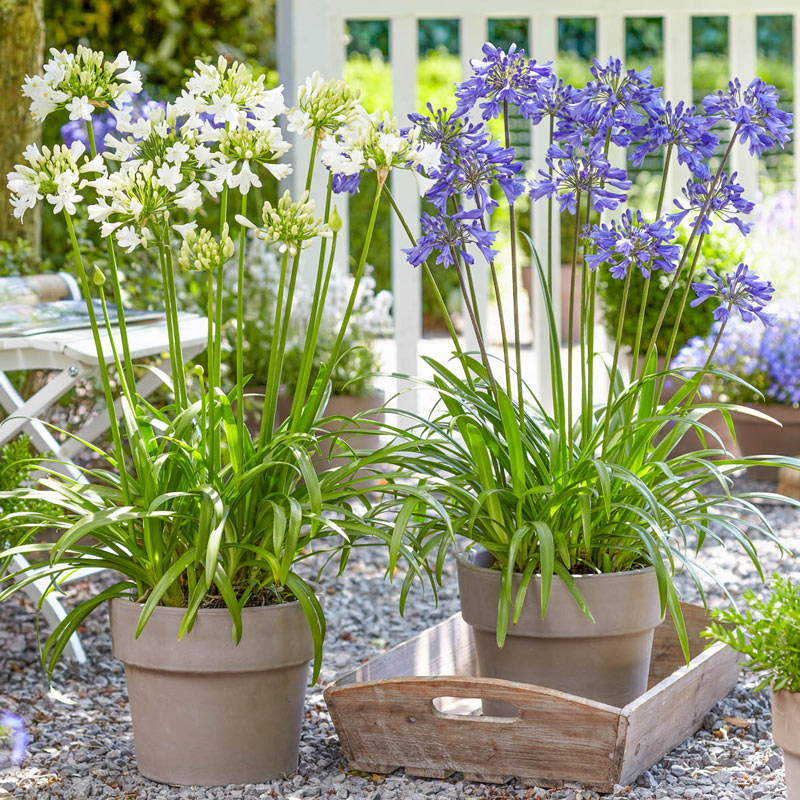Expanding Agapanthus: A Full Guide to Beautiful Blooms
Expanding Agapanthus: A Full Guide to Beautiful Blooms
Blog Article
Releasing the Secret to Effective Agapanthus Growing: Advice for a Flourishing Yard
In the realm of horticulture, growing agapanthus efficiently calls for a critical technique that incorporates numerous aspects of plant care. With careful focus to information, one can open the keys to supporting these stunning blooms, causing a garden that flourishes with beauty and vibrancy. By comprehending the subtleties of agapanthus cultivation, one can develop an atmosphere where these plants thrive and grow generously. In the following discussion, we will certainly discover crucial tips and tricks that will certainly guide you towards a thriving agapanthus yard, providing understandings right into ideal practices, soil conditions, sprinkling methods, and a lot more.
Planting Agapanthus: Finest Practices
When planting Agapanthus, proper dirt prep work is important for making certain successful development and development of these lovely flowers. Agapanthus, commonly referred to as Lily of the Nile or African lily, flourishes in well-draining soil with a slightly acidic to neutral pH degree - Agapanthus. Before growing, it is crucial to amend heavy clay dirts with raw material such as compost or peat moss to enhance drain and supply important nutrients for the plants
To grow Agapanthus, pick an area that receives complete sunlight to partial color, as this will promote healthy and balanced development and bountiful flowering. Dig a hole twice the size of the plant's origin ball and place the Agapanthus at the exact same deepness it was formerly expanding. Carefully backfill the opening with soil, weighing down strongly to remove any type of air pockets around the roots.
Water the recently planted Agapanthus completely and proceed to maintain the soil uniformly damp, particularly throughout the plant's active expanding season. Agapanthus. Using a balanced plant food once a month can even more support the plant's development and blooming. By complying with these best practices for planting Agapanthus, you can develop a stunning display screen of these exciting flowers in your yard
Suitable Soil Conditions for Agapanthus
For optimal growth and blooming success of Agapanthus plants, ensuring the dirt problems are excellent is crucial. Agapanthus likes soil that is abundant in nutrients, so integrating a balanced plant food during the growing period can promote healthy and balanced growth and vivid flowers.

Watering and Feeding Tips
To make certain healthy and balanced development and vivid flowers, correct watering and fertilizing strategies are vital for effective Agapanthus growing. Agapanthus plants profit from routine watering, particularly throughout the growing season.
When it pertains to fertilizing Agapanthus, a well balanced plant food with equivalent components nitrogen, phosphorus, and potassium can be applied in the spring to promote healthy growth and blooming. Slow-release plant foods are perfect for visite site giving nutrients progressively over a prolonged period. Prevent over-fertilizing, as this can bring about extreme vegetation growth at the expenditure of flowers.
In addition, incorporating raw material like compost right into the dirt can boost nutrient levels and improve dirt structure, aiding in the total wellness of the Agapanthus plants. By adhering to these watering and fertilizing ideas, garden enthusiasts can guarantee their Agapanthus plants flourish and produce stunning screens of flowers.
Pruning and Deadheading Methods
Proper trimming and deadheading techniques play a crucial function in preserving the health and aesthetics of Agapanthus plants, matching the essential methods of watering and fertilizing for effective cultivation. Trimming Agapanthus includes removing spent blossom heads, dead or yellowing fallen leaves, and total shaping of the plant to advertise far better growth. Deadheading, the process of eliminating faded blossoms, not only boosts the plant's appearance but additionally motivates further flowering.
When deadheading Agapanthus, it is suggested to clip off the flower stem at the base utilizing sharp, clean shears. This process redirects the plant's energy from seed manufacturing back right into origin and vegetation growth, promoting a much healthier and a lot more durable plant. Regular deadheading can prolong the flowering duration of Agapanthus and avoid self-seeding, which can cause overcrowding.
In terms of trimming, Agapanthus typically advantages from a light trim after blossoming to clean the plant and urge fresh growth. Cutting back the invested blossom stems and eliminating any type of damaged or dead foliage helps preserve the plant's vigor and general look. Nonetheless, it is necessary to stay clear of cutting into the crown of the plant, as this can weaken its health.

Protecting Agapanthus From Pests and Diseases
Implementing effective pest and disease administration techniques is critical to safeguarding the health and wellness and vigor of Agapanthus plants in farming. One usual pest that affects Agapanthus is the Agapanthus borer, a caterpillar that passages right into the plant, creating damage to the leaves and flowers.
In enhancement to parasites, Agapanthus are prone to diseases web link such as root rot and fungal fallen leave spots. By staying vigilant and addressing insect and illness concerns quickly, gardeners can aid their Agapanthus grow and prosper.

Final Thought
To conclude, successful cultivation of agapanthus calls for correct planting strategies, excellent soil conditions, ample watering and fertilizing, normal pruning and deadheading, and protection from insects and diseases. By adhering to these tricks and ideas, garden enthusiasts can make certain a growing yard full of gorgeous agapanthus blooms. Agapanthus. Bear in mind to keep regular treatment and interest to detail to advertise the wellness and longevity of these magnificent plants
When planting Agapanthus, correct soil preparation is vital for ensuring successful development and growth of these gorgeous flowers.Water the freshly grown Agapanthus completely and proceed to maintain the dirt uniformly moist, especially during the plant's energetic expanding period.For optimal development and blooming success of Agapanthus plants, guaranteeing the soil problems are perfect is important. When transplanting or growing Agapanthus, make sure the soil is well-prepared to give the necessary structure for the plants to develop themselves successfully. One typical pest that influences Agapanthus is the Agapanthus borer, a caterpillar that tunnels right into the plant, triggering damage to the leaves and flowers.
Report this page